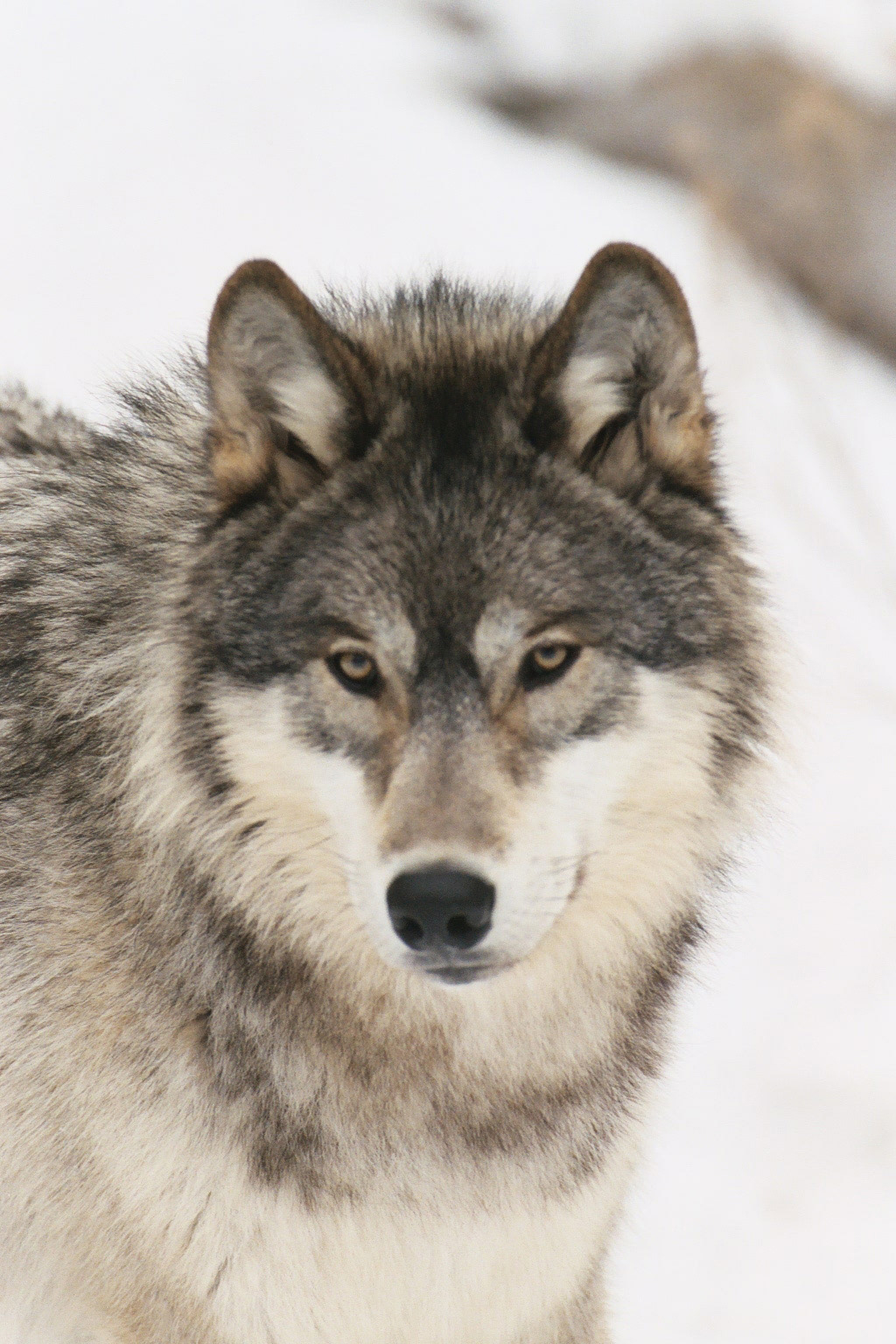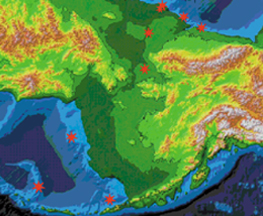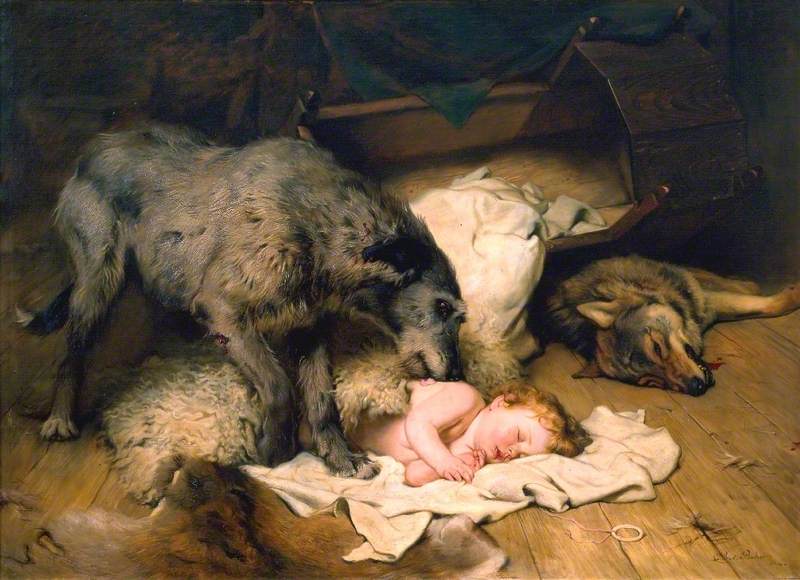Based on the book "The last wolf", by Jim Crumley, I'd like to write some paragraphs in defense of my favourite creature on Earth: the wolf. In fact, this animal has been pursued and brutally killed in numerous places in the planet due to a feeling of hatred widely spread among the humankind.
However, this feeling has not always been shared by humans.
A) LGM - Prehistory.
If we go back in time to the Pleistocene, wolves were the most widespread mammals, and the first to be domesticated. During the Last Glacial Maximum (Some 20,000 years ago), the sea level was lower, which created a land bridge between Asia and North America in the current Bering Strait (see picture 1). Big American herbivores took advantage of this connection and crossed it, finding really rich grassland areas on the other side. Wolves pursued these herbivores and gradually pushed them towards the west and that's the reason why horses reached the westernmost parts of Europe.
After the glaciation, Canis lupus (wolves) and Homo sapiens could adapt to the environment relatively easily. Despite both being hunters, wolves were better, so humans learn from wolves to hunt more effectively, thus treating the wolf as a teacher. Evidence of this remains in paintings, carving, writings and word-of-mouth.
B) Beginning of human civilizations.
Humans fell out with wolves when they started to be sedentary. Along with the invention of fire, the mankind could create meadows when there were forest (therefore destroying wolves' habitat) so their domestic animals could graze on them. Yet, needs to protect the cattle from wolves arose, which would oppose the human race and wolves.
However, the myth of Romulus and Remus, founders of Rome that were fed by a she-wolf and brought peace with the Sabines (whose worship animal was the wolf) restored wolf's previous high status.
C) Christianity and the Middle Age.
When Christianity came, as it considered God a good shepherd, wolves eating livestock were the personification of Devil. As a result, hundreds of myths of ferocious big black wolves attacking normal people were formulated, which led to hatred towards this species that is still deeply rooted in the human population. In this book, the author tries to dispel some of these myths:
- First of all, we should take into account that myths change greatly and very rapidly over time, and tend to progressively exaggerate reality. For example, wolves are described bigger than they actually are (see Picture 2) and most people that have never seen a wolf think this way. Moreover, no black wolves have been found in Europe, whereas lots of stories told in Scotland describe fierce black wolves.
- Secondly, deer, reindeer, moose, goat and wild boar are wolves' favourite prey, which means that only if they disappear wolves will start preying cattle. Therefore, if wolves started hunting cattle was because humans also were chasing the other animals mentioned before.
- Furthermore, such stories told in Scotland contained incredible and magnificent aspects (cf Picture 3): there was a strong and tall hero, quite similar to William Wallace, by the way; this could be explained because the Victorians heard these stories when they were building the monument in honour of William Wallace in Stirling. This character struggled with a really big a fierce wolf that put his life in risk, but something heroic eventually occurred leading to a highly astonishing death of the creature.
- These characteristics are far more common in which is known as the last-wolf syndrome tales. This concept explains how thrilled humans were to be the one that executed the last wolf of the country (an example is shown in picture 4). Therefore, numerous tales narrated how many last wolves were killed in different parts of the country and besides, all of them contained the same features: there was a big she-wolf protecting her litter, which was even more fierce and terrigying than ever, and the hero had a very dangerous battle with the wolf until the hero showed his abilities and superiority in a last movement that put the big creature to death. The similarities between all these stories make us question about their degree of reliability. Most likely, they're not true and the last wolf may have died from a simple death; in fact, in one place it's claimed that a housewife with a frying pan hit the last wolf, thereby killing it.
- Finally, surnames of important warriors and kings containing the word wolf evidence the high status conceded by this species. Such surnames are Ethelwulf (the Noble Wolf), Berthwulf (the Illustrious Wolf), Eadwulf (the Prosperous Wolf) and Ealdwolf (the Old Wolf).
D) Current times.
Still during the 20th and 21st century, we can observe lots of prejudices towards the wolf. As an example, I'm leaving an extract of an English children textbook from the 19th century:
"A savage aspect, a frightful howl, an insupportable odour, fierce habits, and a malignant disposition are the leading qualities in its nature, which render it dangerous and detested when living and useless when dead. For this reason, hunting the wolf is a favourite diversion among the great in some countries; and it is a species of the chase at which reason need not blush, nor humanity drop a tear."
Nevertheless, the wolf plays an essential role in the ecosystems where it dwells. Indeed, the extermination of them in Scotland lead to landscape degradation, as the lack of this predator made herbivores reproduce uncontrollably, which prevented forests from developing and eventually drived forest degradation.
Luckily, some places have already realised how necessary wolves are in the ecosystems and have made big efforts to reintroduce them to their habitats. This is the case of Yellowstone (cf Picture 5), where the coming of wolves was carried out thanks to the Nez Perce tribe. Their arrival brought about the recovery of willow, which in turn attracted beavers that created aquatic ecosystems where reptiles, amphibians, moose and other animals could flourish. This phenomenon is known in ecology as a trophic cascade, brought about by a single animal.
E) CONCLUSION
I would like to summarise some points commented above to finish this text:
- Firstly, as we behaved as animals, we considered all creatures our peers (we even prayed before hunting to invoke forgiveness for the following acts), except the wolf which, being better at hunting, obtained a higher status and was considered a teacher.
- It was only when the human became sedentary, and later on got worse with Christianity, that the wolf started being despised and pursued, as it became a threaten to cattle. Yet we said that before cattle, wolves prefer to prey other animals (deer, moose...) and go for cattle when the former disappear.
- Myths about wolves trying to kill people were very numerous in the Middle Age and all exaggerated the wolf's features to make it more aggresive and fierce against humans. Consequently, humans were frightened when hearing wolves howling, because they thought the hunting wolf was close, even though it could be up to 5 miles away; in addition, howling is a communication symptom, since wolves hunt in silence. Wolves were thought to howl at the Moon, but that's not true; the only piece of truth within this is that wolves use to hunt when there's Full Moon, as there's more light during this time.
- These medieval beliefs are still part of most of the population's opinion about this animal. People fear them, even if wolves seldom kill humans (as we said, they prefer some wild animals, then cattle); actually, more people die from attacks from domestic dogs than from wolves.
- Reintroduction of wolves, to their habitats although slowly, is taking place, especially thanks to tribes such as Nez Perce (cf Picture 6). It's funny to check that the closer a tribe lived to wolves, the more they liked them, as they were away from all these fake myths so rooted in urban cultures. Moreover, the restoration of wolves has been proved to bring benefits to the ecosystem because they hunt herbivores that otherwise, wouldn't let a forest freely develop.
In conclusion, although I think the author describes wolves as if they were harmless little cats, I mostly agree with him and share his opinions about the strong need to bring them back to the habitats they once occupied. Of course, this could be a problem for farmers or shepherds, but we should also think about the ecologic benefits their introduction would bring to our more and more degraded landscapes.
BIBLIOGRAPHY
CRUMLEY, J. (2010). The last wolf.
Source: http://howlingforjustice.files.wordpress.com/2011/06/winter-wolf-all-about-wolves.jpg
However, this feeling has not always been shared by humans.
A) LGM - Prehistory.
If we go back in time to the Pleistocene, wolves were the most widespread mammals, and the first to be domesticated. During the Last Glacial Maximum (Some 20,000 years ago), the sea level was lower, which created a land bridge between Asia and North America in the current Bering Strait (see picture 1). Big American herbivores took advantage of this connection and crossed it, finding really rich grassland areas on the other side. Wolves pursued these herbivores and gradually pushed them towards the west and that's the reason why horses reached the westernmost parts of Europe.
Picture 1: Bering Strait during the LGM. Green areas represent land over sea level.
Source: http://www.geotimes.org/jan03/feature2_topLGM.jpg
After the glaciation, Canis lupus (wolves) and Homo sapiens could adapt to the environment relatively easily. Despite both being hunters, wolves were better, so humans learn from wolves to hunt more effectively, thus treating the wolf as a teacher. Evidence of this remains in paintings, carving, writings and word-of-mouth.
B) Beginning of human civilizations.
Humans fell out with wolves when they started to be sedentary. Along with the invention of fire, the mankind could create meadows when there were forest (therefore destroying wolves' habitat) so their domestic animals could graze on them. Yet, needs to protect the cattle from wolves arose, which would oppose the human race and wolves.
However, the myth of Romulus and Remus, founders of Rome that were fed by a she-wolf and brought peace with the Sabines (whose worship animal was the wolf) restored wolf's previous high status.
C) Christianity and the Middle Age.
When Christianity came, as it considered God a good shepherd, wolves eating livestock were the personification of Devil. As a result, hundreds of myths of ferocious big black wolves attacking normal people were formulated, which led to hatred towards this species that is still deeply rooted in the human population. In this book, the author tries to dispel some of these myths:
- First of all, we should take into account that myths change greatly and very rapidly over time, and tend to progressively exaggerate reality. For example, wolves are described bigger than they actually are (see Picture 2) and most people that have never seen a wolf think this way. Moreover, no black wolves have been found in Europe, whereas lots of stories told in Scotland describe fierce black wolves.
Picture 2: European wolves hunting deer. Notice the height difference.
Source: http://www-tc.pbs.org/wnet/nature/files/2008/08/610_ag_graywolf1.jpg
- Secondly, deer, reindeer, moose, goat and wild boar are wolves' favourite prey, which means that only if they disappear wolves will start preying cattle. Therefore, if wolves started hunting cattle was because humans also were chasing the other animals mentioned before.
- Furthermore, such stories told in Scotland contained incredible and magnificent aspects (cf Picture 3): there was a strong and tall hero, quite similar to William Wallace, by the way; this could be explained because the Victorians heard these stories when they were building the monument in honour of William Wallace in Stirling. This character struggled with a really big a fierce wolf that put his life in risk, but something heroic eventually occurred leading to a highly astonishing death of the creature.
Picture 3: Welsh
tale of Gelert. Llywelyn the Great, killed his faithful dog Gelert after
finding him covered in blood which he presumed belonged to his baby
son. Only later does he discover that his son is still alive, as his dog
had been fighting with a wolf killed by Gelert to defend the young
prince.
Source: http://upload.wikimedia.org/wikipedia/commons/e/e0/Gelert.jpg
- These characteristics are far more common in which is known as the last-wolf syndrome tales. This concept explains how thrilled humans were to be the one that executed the last wolf of the country (an example is shown in picture 4). Therefore, numerous tales narrated how many last wolves were killed in different parts of the country and besides, all of them contained the same features: there was a big she-wolf protecting her litter, which was even more fierce and terrigying than ever, and the hero had a very dangerous battle with the wolf until the hero showed his abilities and superiority in a last movement that put the big creature to death. The similarities between all these stories make us question about their degree of reliability. Most likely, they're not true and the last wolf may have died from a simple death; in fact, in one place it's claimed that a housewife with a frying pan hit the last wolf, thereby killing it.
Picture 4: Memorial to the last wolf in Sutherland, Scotland.
Source: http://www.landsendjohnogroats.info/images/northern_scotland/570/67_helmsdale6.jpg
- Finally, surnames of important warriors and kings containing the word wolf evidence the high status conceded by this species. Such surnames are Ethelwulf (the Noble Wolf), Berthwulf (the Illustrious Wolf), Eadwulf (the Prosperous Wolf) and Ealdwolf (the Old Wolf).
D) Current times.
Still during the 20th and 21st century, we can observe lots of prejudices towards the wolf. As an example, I'm leaving an extract of an English children textbook from the 19th century:
"A savage aspect, a frightful howl, an insupportable odour, fierce habits, and a malignant disposition are the leading qualities in its nature, which render it dangerous and detested when living and useless when dead. For this reason, hunting the wolf is a favourite diversion among the great in some countries; and it is a species of the chase at which reason need not blush, nor humanity drop a tear."
Nevertheless, the wolf plays an essential role in the ecosystems where it dwells. Indeed, the extermination of them in Scotland lead to landscape degradation, as the lack of this predator made herbivores reproduce uncontrollably, which prevented forests from developing and eventually drived forest degradation.
Luckily, some places have already realised how necessary wolves are in the ecosystems and have made big efforts to reintroduce them to their habitats. This is the case of Yellowstone (cf Picture 5), where the coming of wolves was carried out thanks to the Nez Perce tribe. Their arrival brought about the recovery of willow, which in turn attracted beavers that created aquatic ecosystems where reptiles, amphibians, moose and other animals could flourish. This phenomenon is known in ecology as a trophic cascade, brought about by a single animal.
Picture 5: Wolf Pack living in Yellowstone, reintroduced thanks to the Nez Perce tribe.
Source: http://www.wolftracker.com/TheWildSide/nez%20perce%20april%2012%20a.jpg
E) CONCLUSION
I would like to summarise some points commented above to finish this text:
- Firstly, as we behaved as animals, we considered all creatures our peers (we even prayed before hunting to invoke forgiveness for the following acts), except the wolf which, being better at hunting, obtained a higher status and was considered a teacher.
- It was only when the human became sedentary, and later on got worse with Christianity, that the wolf started being despised and pursued, as it became a threaten to cattle. Yet we said that before cattle, wolves prefer to prey other animals (deer, moose...) and go for cattle when the former disappear.
- Myths about wolves trying to kill people were very numerous in the Middle Age and all exaggerated the wolf's features to make it more aggresive and fierce against humans. Consequently, humans were frightened when hearing wolves howling, because they thought the hunting wolf was close, even though it could be up to 5 miles away; in addition, howling is a communication symptom, since wolves hunt in silence. Wolves were thought to howl at the Moon, but that's not true; the only piece of truth within this is that wolves use to hunt when there's Full Moon, as there's more light during this time.
- These medieval beliefs are still part of most of the population's opinion about this animal. People fear them, even if wolves seldom kill humans (as we said, they prefer some wild animals, then cattle); actually, more people die from attacks from domestic dogs than from wolves.
- Reintroduction of wolves, to their habitats although slowly, is taking place, especially thanks to tribes such as Nez Perce (cf Picture 6). It's funny to check that the closer a tribe lived to wolves, the more they liked them, as they were away from all these fake myths so rooted in urban cultures. Moreover, the restoration of wolves has been proved to bring benefits to the ecosystem because they hunt herbivores that otherwise, wouldn't let a forest freely develop.
Picture 6: Nez Perce woman drawn with a wolf.
Source: http://photos.igougo.com/photos/journal/pref/Nez_Perce_woman_and_pet_wolf_prefRes.jpg
In conclusion, although I think the author describes wolves as if they were harmless little cats, I mostly agree with him and share his opinions about the strong need to bring them back to the habitats they once occupied. Of course, this could be a problem for farmers or shepherds, but we should also think about the ecologic benefits their introduction would bring to our more and more degraded landscapes.
BIBLIOGRAPHY
CRUMLEY, J. (2010). The last wolf.











4 comentarios:
adidas yeezy
jordan shoes
coach factory outlet
adidas outlet
uggs canada
ugg outlet
jordan shoes
pandora charms
adidas nmd
canada goose outlet
cc20181026
goyard
golden goose
supreme clothing
golden goose
golden goose
supreme outlet
supreme hoodie
goyard
balenciaga
golden goose outlet
find more Louis Vuitton fake Bags useful reference bags replica gucci article source Louis Vuitton replica Bags
h7a79j4j53 s1y82a8t69 l7k96p3x38 q8p58e6a50 b7h01t9g27 v8i63w9d55